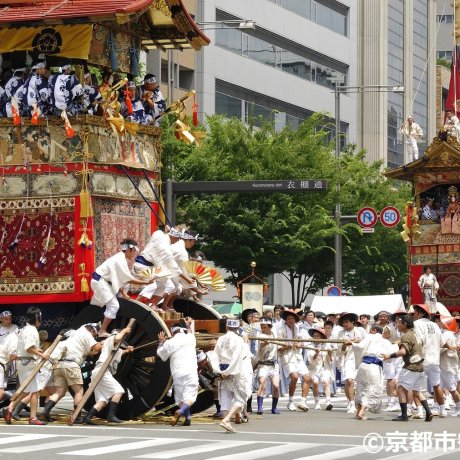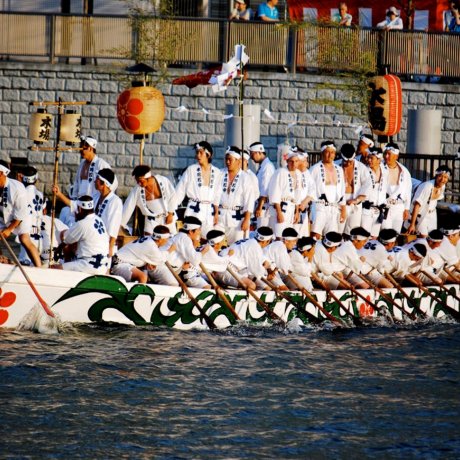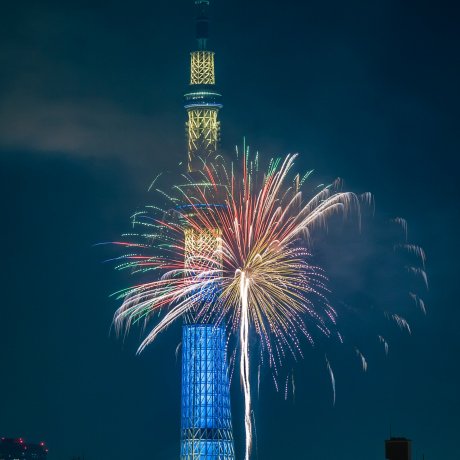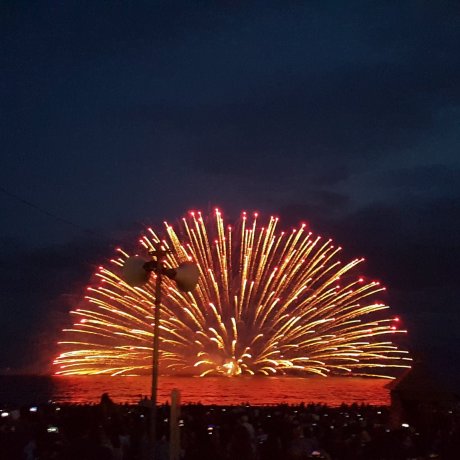Summer in Japan is made for getting out there. It’s a season that doesn’t stay still, with festivals filling the streets and trains packed with families heading toward the coast or the mountains. The days feel long, stretched by the buzz of cicadas and the soft glow of lanterns in the evening.
For some, Japan’s summer can be overwhelming. But it’s also part of the atmosphere that defines this time of year, where everything feels alive and a little amplified. You don’t need to plan every hour, but having a few essentials sorted—like when to go, where to cool off, and what local events are happening—can make all the difference between simply enduring the season and fully enjoying it.
Summer Months in Japan
Summer in Japan begins in June, as the rainy season (baiu) rolls in across much of the country. While early summer is wet and overcast, the skies clear by July, making way for hot, sunny days and an explosion of festivals, fireworks, and outdoor activities. August is the height of the season, with temperatures frequently exceeding 30°C in many regions, accompanied by high humidity. Despite the heat, this is one of the most energetic times to explore Japan—if you come prepared.
Summer Temperatures by Region
Like spring, summer in Japan varies widely depending on geography. From the breezy highlands of Nagano to the tropical waters of Okinawa, each region experiences the season differently. Knowing what to expect can help you plan cooler getaways or take advantage of local events without being overwhelmed by the heat.
Northern Japan
Nothern Japan experiences warm summers, especially on the Sea of Japan side and in mountainous areas. Cities like Sapporo and Aomori typically enjoy average highs between 24°C and 28°C in July and August, with lower humidity than the rest of Japan. The cooler climate and lush natural landscapes make it a popular destination for outdoor travelers looking to escape the heat of the central and southern regions.
Eastern Japan
Eastern Japan, including Tokyo and much of the Kanto region, has hot and humid summers. Summer temperatures often reach 30°C or more, and the humidity can make city travel feel even hotter. Despite this, the region buzzes with energy during the summer months. Tokyo and surrounding areas are packed with festivals, fireworks displays, and outdoor events. For those wanting cooler air, mountain getaways like Nagano and Yamanashi offer refreshing escapes within easy reach of the city.

Western Japan
Western Japan, which includes cities like Kyoto, Osaka, and Hiroshima, is known for very hot and humid summers, with daytime temperatures often reaching 35°C or above. While the summer heat can be intense, it also sets the stage for some of the country's most iconic festivals, such as Kyoto’s Gion Matsuri and Osaka’s Tenjin Matsuri. Travelers should plan sightseeing in the early morning or late afternoon and take frequent breaks to stay cool.
Southern Japan
Okiinawa and Amami belong to a subtropical oceanic climate zone. These areas experience hot and humid summers, though temperatures rarely exceed 35°C. Summer here is marked by crystal-clear waters, coral reefs, and a more laid-back pace of life. While the rainy season starts early, often in late May, it usually ends by late June, giving way to sunny skies and ideal conditions for beach activities. This region is a favorite for diving, snorkeling, and relaxing island holidays, but travelers should monitor typhoon forecasts, especially from late July through September.
What to Wear for the Heat
With high humidity and temperatures regularly exceeding 30°C, especially in July and August, the right clothing can help you enjoy the summer season in Japan without feeling overwhelmed. What you wear makes a difference, particularly if you plan to spend long hours outdoors or exploring on foot.
Breathable Basics
- Fabric Choice: Lightweight, breathable materials like cotton, linen, or moisture-wicking synthetics to help release body heat and manage sweat.
- Fit: Loose-fitting clothing such as wide-leg pants, relaxed shirts, and flowy dresses for improved airflow and comfort.
- Color: Light-colored clothing to reflect sunlight and stay cooler compared to darker tones.
- Footwear: Shoes should be lightweight, breathable, and easy to walk in. Sandals are popular, but breathable sneakers or slip-ons with good ventilation are practical for longer outings.

Essential Summer Items
- Sun Hat or Cap: wide-brimmed hat or baseball cap offers important protection from direct sunlight, especially during midday hours.
- Sunglasses: Opt for lenses with UV protection to avoid eye strain on bright days.
- Light Scarf or UV Sleeves: Many locals use these for sun protection without relying on sunscreen alone.
- Folding Fan or Small Portable Fan: Easily found in convenience stores or department stores, these help when shade or breeze is hard to find.
- Hand Towel or Small Cloth: For wiping away sweat throughout the day.
- Compact Umbrella: A staple in Japan, it’s handy for surprise rain showers and can also double as a sunshade.
- Cool Wipes (Refreshing Sheets): Available at drugstores and convenience stores, these menthol-infused sheets quickly refresh your skin and leave a cooling sensation, especially helpful after being out in the sun.
- Portable Ice Packs or Cooling Gel Sheets: Stick-on cooling gel sheets or small reusable ice packs are lifesavers in high heat. Great for applying to the neck, forehead, or wrists for fast relief.

Packing Tips
Pack light and practical. Choose versatile clothing made from breathable fabrics that dry quickly and layer easily if needed. Since Japan's summer is hot and humid, it's smart to bring a few extra tops in case you need to change mid-day. If you’re planning to hike, attend festivals, or visit coastal areas, bring activity-appropriate gear—but leave bulky items like sun umbrellas or large fans behind. These are easy to buy or rent locally at convenience stores, outdoor shops, or travel hubs. Prioritize items that keep you cool, comfortable, and protected from the sun without overloading your luggage.
Indoor Cooling and Ventilation
Japanese homes, hotels, and other rental options like Airbnbs are generally equipped with air conditioning to keep you comfortable during the summer. But if you’re a newly-arrived foreign resident, a long-term visitor, or someone staying in a budget-friendly place with minimal cooling or ventilation, here’s how to stay cool in your private spaces:
Air Conditioning: Most accommodations include wall-mounted A/C units, but settings can be confusing at first. Learn how to switch between cooling, dehumidifying, and energy-saving modes. If the unit isn’t working efficiently, don’t hesitate to ask your host or building manager.
Electric Fans: A reliable electric fan can help circulate air and reduce stuffiness. If your accommodation doesn’t provide one, they’re widely available at electronics stores, supermarkets, and discount shops like Don Quijote.
Window Screens and Ventilation: Opening windows in the early morning or late evening can bring in cooler air, but make sure insect screens are in place. Many apartments and older homes don’t have central ventilation, so creating airflow is essential.
Cooling Bedding and Sheets: Consider using breathable bedding materials like cotton or linen, and look for cooling sheets or mattress pads designed for summer. These are sold at stores like Nitori, Muji, and most home centers.
Light Sleepwear: Pack or purchase sleepwear made of breathable, moisture-wicking fabric. Cotton T-shirts and shorts work well, but quick-dry loungewear designed for summer can make nights more comfortable.
Dehumidifiers: Summer humidity can be draining. If your space doesn’t have a built-in dehumidifier, compact models are available for rent or purchase and can significantly improve comfort indoors.
Transportation by Land and Air
Japan’s transportation network remains one of the most efficient in the world, making it easy to explore the country during the busy summer months. High-speed trains, domestic flights, buses, and well-connected local transit systems ensure that both urban and rural destinations are accessible. While summer lacks the severe weather disruptions of winter, it does come with its own considerations, particularly around peak travel times and seasonal congestion. Here are some tips to help you navigate your summer travels in Japan:
Plan Ahead During Peak Travel Periods
Summer includes several national holidays and school breaks, which can lead to crowded trains, busy airports, and full hotels—especially during Obon (Japan’s Festival of Spirits) in mid-August. Reserve train seats in advance where possible, particularly on popular routes like Tokyo to Kyoto or Osaka to Hiroshima. Expect long queues at stations during festival weekends and consider traveling early in the day to avoid the rush.

Stay Cool While in Transit
Most public transport is air-conditioned, but platforms, bus stops, and regional train cars without strong A/C can get uncomfortably warm. Keep a water bottle on hand, and consider carrying a folding fan or portable electric fan. Some local lines, especially in rural areas, may not run frequently, so plan layovers with heat and shade in mind.
Use the JR Rail Pass for Long-Distance Travel
The JR Pass remains a great option for exploring Japan by train, especially for travelers visiting multiple cities. Shinkansen and limited express trains are fast, comfortable, and air-conditioned—ideal for covering long distances in the summer heat. Be sure to reserve seats ahead of time if you’re traveling during busy festival weeks.
Skip the Jams When Possible
While renting a car gives you flexibility, Japan’s summer highways, particularly near beach destinations, theme parks, and festival sites, can become heavily congested. Expressways may also be impacted by temporary road closures due to local events. For most travelers, trains offer a more efficient way to reach summer destinations, particularly in and around cities.
Use Local Transit and Alternative Options
In both cities and rural towns, buses, subways, and trams are reliable and widely used. However, service may end earlier in some rural areas, especially on weekends. Plan accordingly if you’re attending a night festival or fireworks show. Taxis and ride-hailing services like Uber are also available in most urban centers but can be expensive and hard to find during peak hours or large events.
Summer Festivals in Japan You Shouldn’t Miss
Summer in Japan is all about color, celebration, and community. The season is packed with unforgettable festivals that bring both locals and visitors together. With good timing and a bit of preparation, you can immerse yourself in Japan’s summer spirit while experiencing its rich cultural heritage. Here are some must-see summer festivals to inspire your warm-weather travels:
Gion Matsuri (Kyoto)
Held throughout the month of July, Gion Matsuri is one of Japan’s most famous and historic festivals. Centered in Kyoto’s downtown area, the event features yamaboko (festival floats) paraded through the streets, traditional music, and nightly street stalls. The grand procession, held on July 17 and 24, is the highlight of the month-long celebration.
Pro Tip: Visit in the evenings during the "Yoiyama" lead-up nights to see the floats illuminated and enjoy local street food without the midday heat.

Gion Matsuri 2026
Enjoy centuries old traditions, lively parades, mouth-watering street food, and contagious fun at one of Japan’s most popular ..
Aomori Nebuta Matsuri (Aomori)
Known for its massive illuminated paper floats depicting warriors, gods, and mythical creatures, the Aomori Nebuta Matsuri is a powerful visual and musical spectacle. Taiko drummers, haneto (festival jump dancers), and musicians parade alongside the glowing floats through the streets each night.
Pro Tip: You can join in the dancing if you rent or wear a haneto costume—check ahead for rental locations and requirements.

Aomori Nebuta Festival 2025
Nebuta festival is the biggest Tanabata festival that makes up the three great festivals of Tohoku Region.
Tenjin Matsuri (Osaka)
Tenjin Matsuri combines land and water celebrations in a festival that’s over a thousand years old. The highlight is the river procession, where boats adorned with lanterns float along the Okawa River before a massive fireworks finale.
Pro Tip: Book riverfront seating or get there early to claim a viewing spot along the banks for the fireworks and boat parade

Tenjin Matsuri 2026
Tenjin Matsuri, which literally means festival of the Gods, is one of the most symbolic water and light festivals in Osaka, held..
Gujo Odori (Gifu)
Gujo Odori is a traditional Bon Odori dance festival held in the mountain town of Gujo Hachiman. The dances are open to everyone, and the most famous nights—called "tetsuya odori"—run until sunrise. The atmosphere is joyful, communal, and steeped in tradition.
Pro Tip: Wear a yukata and join the locals in the circle dance. It’s one of the most immersive summer festival experiences you can have.
Sumidagawa Fireworks Festival (Tokyo)
Held near Asakusa along the Sumida River, this is one of Tokyo’s largest and oldest fireworks displays. It draws massive crowds each year and features tens of thousands of fireworks lighting up the Tokyo skyline.
Pro Tip: Arrive early and bring a picnic mat for the best riverside viewing spots. If you're staying nearby, watching from your hotel room is a relaxing alternative.

Sumidagawa Fireworks Festival 2026
The Sumidagawa Fireworks Festival around the Tokyo Skytree is one of Japan's major summer fireworks displays, held each year..
Kamakura Fireworks Festival (Kanagawa)
Set along Yuigahama Beach, the Kamakura Fireworks Festival offers a stunning coastal backdrop to one of the region’s most beloved summer events. Launched over the water, the fireworks reflect across the bay for a uniquely scenic show. The casual beach atmosphere and cool sea breeze make this event especially popular with both locals and visitors.
Pro Tip: Bring a beach mat and arrive early to claim a spot on the sand. Consider combining the event with a day of sightseeing around Kamakura’s temples and cafes.

Kamakura Fireworks 2026
Kamakura Fireworks are known for their speciality “underwater fireworks”. which explodes in the water, creating a beautiful, c..
Summer Activities You Should Try
Festivals are just one way to enjoy the season. Summer in Japan is rich with experiences, offering something for every kind of traveler—outdoor adventurers, cultural explorers, or those simply looking to relax and unwind. From island hopping and river cruises to stargazing in remote highlands, there’s no shortage of ways to make the most of the season. Here are some of the top summer activities in Japan and where to enjoy them.
Island Hopping and Beach Escapes
Beyond its major cities, Japan’s islands offer a different rhythm, especially in summer. With soft waves, quiet beaches, and warm breezes, these summer destinations are perfect for both romantic getaways and solo soul-searching escapes.
- Okinawa Main Island and Surrounding Islands: Pristine beaches, coral reefs, and clear turquoise waters make Okinawa perfect for diving, snorkeling, and swimming. Islands like Tokashiki, Zamami, and Ishigaki offer a more relaxed pace and are reachable by ferry or short flight.
- Naoshima (Kagawa): Known as Japan’s “art island,” Naoshima is ideal for art and architecture lovers, but it also offers quiet beaches and beautiful sea views. Rent a bike and explore at your own pace.
- Shirahama Beach (Wakayama): A popular beach resort within reach of Osaka, Shirahama is known for white sand, family-friendly amenities, and nearby hot springs.
- Enoshima and Kamakura (Kanagawa): Just outside Tokyo, these coastal spots are perfect for a quick seaside escape. Visit temples, eat fresh seafood, and cool off by the shore.

Hiking and Nature Trails
Summer is also a great time to explore Japan’s mountains and highlands, which offer cooler temperatures and stunning landscapes. From casual forest walks to multi-day treks, nature lovers have plenty to choose from.
- Kamikochi (Nagano): Located in the Japanese Alps, Kamikochi offers dramatic mountain views, cool summer air, and accessible walking trails through riverside forests.
- Mount Daisen (Tottori): One of western Japan’s best summer hikes, Mount Daisen features scenic trails and panoramic views of the Sea of Japan.
- Oze National Park (Gunma/Niigata/Fukushima): This highland marshland offers wooden walkways and fields of seasonal wildflowers. It’s peaceful, easy to navigate, and ideal for a day trip or overnight hike.
- Yakushima (Kagoshima): A UNESCO World Heritage Site, Yakushima is home to ancient cedar forests and misty mountain trails. Hiking here is immersive and spiritual, especially in early morning light.

River Rafting and Canoeing
Rivers in Japan flow through some of the country’s most stunning landscapes, making them ideal for summertime outings. Kayaking, rafting, and stand-up paddleboarding offer a refreshing way to enjoy the great outdoors and connect with nature.
- Kuma River (Kumamoto): Known for its gentle rapids and natural beauty, the Kuma River is great for families and groups looking for beginner-friendly water activities.
- Tonegawa (Gunma): A popular spot for whitewater rafting within reach of Tokyo. Guided half-day and full-day trips are available during summer.
- Nagatoro (Saitama): Just north of Tokyo, Nagatoro offers calm riverboat rides and beginner-friendly rafting through a scenic gorge. It’s also a great area for a short hike or barbecue by the riverbank.
Stargazing and Summer Camping
Japan’s rural areas and highlands offer incredible stargazing opportunities and scenic spots for summer camping. This is a peaceful alternative to crowded cities and coastal resorts.
- Achi Village (Nagano): Famous for having some of the clearest skies in Japan. Take the Star Village gondola at night for a spectacular view of the Milky Way.
- Lake Motosu (Yamanashi): Near Mount Fuji, this lake is a favorite for campers and photographers. The night sky reflects beautifully off the water, and it's a popular spot for viewing the Perseids meteor shower in August.
- Shikoku Karst (Ehime/Kochi): This limestone plateau offers panoramic views, cool breezes, and excellent conditions for summer camping under the stars.
Food and Drinks to Keep You Cool
Japan’s summer isn’t complete without tasting the seasonal dishes that locals rely on to stay cool. Alongside the fireworks and beach days, you’ll find shaved ice, cold noodles, and crisp, refreshing drinks that help you manage the heat and humidity. Perfect for festival-goers and beach lovers alike, these summer foods are flavorful and uniquely Japanese.

- Hiyashi Chuka (Chilled Ramen): A cold noodle dish topped with sliced cucumber, ham, egg, and tomato, served with a tangy soy-based or sesame dressing. Popular at ramen shops during the hottest months.
- Somen (Thin Chilled Noodles): Delicate wheat noodles served cold with a light dipping sauce. Often eaten at home or at summer restaurants. Look out for nagashi somen (flowing noodles served along bamboo flumes) for a fun, traditional experience.
- Zaru Soba (Cold Buckwheat Noodles): Served on a bamboo tray with dipping sauce, wasabi, and green onions. This simple and refreshing dish is a classic summer staple found across the country.
- Kakigori (Shaved Ice): A beloved Japanese summer dessert made with finely shaved ice and flavored syrups like matcha, strawberry, melon, or mango. Many shops also offer versions topped with condensed milk, azuki beans, or fruit.
- Mizuyokan (Chilled Sweet Bean Jelly): A smooth, mildly sweet dessert made with red bean paste and agar, served chilled. It's especially popular in tea houses during summer.
- Cold Tofu (Hiyayakko): A refreshing dish made with chilled tofu topped with green onions, grated ginger, soy sauce, and sometimes bonito flakes. Simple, healthy, and easy to find at izakaya or as part of a set meal.
- Summer Street Snacks: Look out for cool festival foods like ice-cold cucumbers on sticks, fruit-flavored jelly cups, and ramune soda with its signature marble-stopper bottle.
- Seasonal Drinks from Vending Machines and Konbinis: Try chilled canned coffee, mugicha (barley tea), sports drinks like Pocari Sweat and Aquarius, and seasonal fruit-flavored beverages—all widely available in vending machines and convenience stores across the country.
- Amazake (Chilled Version): While traditionally served warm in winter, amazake is also available cold in summer. This non-alcoholic fermented rice drink is sweet, nutritious, and easy on the stomach.
- Summer Sake and Craft Beer: Look for seasonal sake served cold, or try Japan’s growing selection of local craft beers, perfect for relaxing on a warm evening. Many festivals and outdoor beer gardens offer icy pints to go with skewers and light snacks.
Summer in Japan moves quickly. Between festivals, fireworks, and long stretches of daylight, it’s a season that keeps you on your feet. But some of the best parts aren’t the headline events—they can also be the quiet breaks in between: stepping into an air-conditioned café, stumbling onto a local market, or catching a breeze on a train platform at dusk. You don’t need to over-plan, but some preparation helps, especially when dealing with the heat or navigating busy travel days. Knowing where to go, and when, gives you the space to actually enjoy the moment when you get there.





























